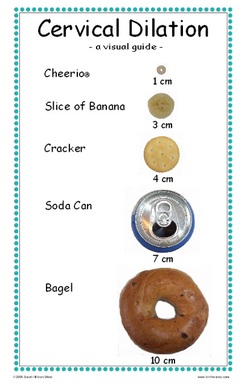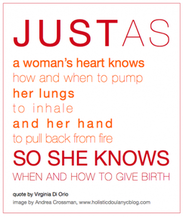|
Congratulations! If you are showing the positive signs of labor (progressive contractions, water breaking, etc.), then a baby is working on making his/her way into this world! At this point in time, you may be feeling a couple of different emotions:
The Realities of Labor and Birth Do you know what a laboring woman truly looks like? It’s okay if you don’t. Actually, I don’t know if there are a lot of people out there that really do. They may have never witnessed a live birth, or they have only been exposed to birth in the media (SO unrealistic). Before I became a doula, I was very naïve. I was unaware of the impact of medical interventions on birth. I didn’t know there were moms out there that were opting for natural birth, let alone giving birth in their homes. I had no idea labors could last +24 hours. I didn’t even know doulas existed. I wasn’t aware that when your water breaks, you don’t have to rush to the hospital. And you definitely don’t have to labor in bed or push while lying on your back. If you already knew these things, how powerful was that moment when you were presented with the realities of birth? Going to my first births as a doula was so eye opening and educational. From my experiences, I wanted to share some general information and tips that can help you better understand and navigate through this process: Childbirth is physiological. There are so many hormones that come into play during labor and birth. If mom is feeling anxious or tense, adrenaline is released. This hormone can hamper labor progress, causing it to stall or stop all together. Laboring mamas need to feel supported—which will cause a release of oxytocin, the “love hormone.” Partners and support people: be in tune with mom’s emotions. Matching her mood and simply being present will positively affect labor progress. You can read more about the role of hormones in labor here. Early labor can last a while and feel mellow or chill. In early labor, distraction is KEY! Engage in regular, everyday activities until you can no longer distract yourself. Do you have a lunch date with girlfriends planned for today but are hesitant because you're in labor? Go ahead out and grab a bite. As one childbirth educator in our community says, you can get pretty fast service if you tell your waiter you’re in labor! ;) But really...take the dog for a walk, call your mom to chat, watch a movie or play some card games with your partner. Do whatever helps to pass the time. Remember that this is the longest stage of labor. If you can manage it, try resting or napping for a period of time. You want to reserve as much energy as possible for the more intense parts of labor. With that being said, eat light foods and keep up your fluid intake. Nourishing your body in the early stages of labor will prevent you from running on empty when you’re pushing your baby out. Call your doula and let her know you are in labor. She may not meet with you at that very moment, but it’s nice to give her a heads up. By the time you are ready for her to join you and your partner, she will have all of her ducks in a row. If you’re planning a hospital birth, try laboring at home for as long as possible. This will help decrease the chance of interventions. If you are feeling lonely or unsure, this would be a good time to invite your doula over. She can provide reassurance, perspective, and suggestions. If mom and baby are both healthy, there is no need for continuous electronic fetal monitoring (EFM). When mom arrives at the hospital, the nurse will want to hook her up to the EFM for about 20-30 minutes. This is just to make sure mom and baby are doing well. Once she assesses mom and baby’s well-being, and everything looks okay, mom will be taken off of the EFM. Typically, the nurse will come in about every hour or so to get a quick reading (subsequent readings are much shorter than the one upon arrival). If labor is moving at a fast pace, the nurse will come in more often. EFM is usually considered necessary when other interventions are introduced, such as Pitocin or an epidural. At prenatal appointments with your care provider, ask for his/her opinion on routine practices and interventions. This may give you a good idea of what to expect once you go into labor. If you find that you are unhappy with the way your care provider handles things prenatally, try switching care providers! Unless you are nearing your due date, it is most likely not too late to switch. Eat to hunger and drink to thirst. I know I mentioned this up above, but it is just so important to note once again! Most hospitals offer clear foods for laboring women. These include: jello, gummy bears, ice chips, popsicles, broth, etc. I encourage expectant mamas to pack light snacks in their hospital bags. Consider brings crackers, granola bars, fruits and veggies, etc. Not nourishing your body in labor can have adverse effects on the laboring process. Movement and breathing are powerful coping mechanisms in labor. Moms will find what works for them in labor, but I always find that breathing techniques and position changes really do the trick. There is no one right way to breathe, but as labor becomes more intense, mom may find that her breathing style changes. Just like transitioning from walking to jogging to running, heart rate and breathing patterns will pick up. Changing positions often will also help with labor progress and baby’s descent. What works in early labor may not work in active labor, and that’s okay! Women typically rely on more than one comfort measure and position to cope with labor pain. Active labor, especially while in the transition phase, is intense! This is the part of labor that media loves to play off of. I always think of Alison screaming, “GET OUT” when giving birth in the movie, “Knocked Up.” Yes, the moments leading up to full dilation can be very intense, but mom may also turn inward. She may be very to herself, very quiet and focused on each contraction. Don’t be alarmed if she is very primal in her labor. She may be moaning, chanting, keeping a rhythm of some sort (Check out Penny Simkin’s write up on "The 3 R’s in Childbirth Preparation" to get a better idea of coping rituals). In this phase of labor, support people often hear mom say, “I can’t do this anymore.” Mom may feel defeated and ready to throw in the towel, especially if she is exhausted. She may ask for pain medications or say, “If I could just go to sleep and wake up tomorrow, I could do this.” This irrationality is totally normal. Offer encouragement and remind her of your birth plan. Often times, laboring mamas get so caught up that they cannot see the light at the end of the tunnel. Remind her that you both are getting a baby out of this! It can be hard to keep that in perspective. There is a resting phase. Before mom enters the 2nd stage of labor, the pushing stage, she may doze off. Support people may be surprised at her ability to relax after such intense and frequent contractions. At this point in time, mom’s uterus is playing catch up and will give her a “break” before she feels the urge to push. Know that this is completely normal, and if mom experiences this lull, encourage her to shut her eyes and rest for a moment. Typically, moms will get a second wind when it’s time to push, but any bit of rest until then will help! Visit the bathroom frequently. This may sound like a "Duh!" statement, but a full bladder can cause labor to stall. If you feel like you have to pee, go sit on the toilet. If you don't, that's cool. But try out some contractions while you're sitting there. As humans, we have this natural instinct to let go when we sit on the toilet. Really opening up and relaxing may be just what you need to dilate fully. You never know! Mom can use spontaneous pushing to get her baby out. When mom is fully dilated, she will be encouraged to push. Remind her to wait for that natural urge. Like I stated above, she may not feel that urge right away, and that’s okay. I think it’s said best in “Our Bodies, Ourselves: Pregnancy and Birth:” “Pushing your baby out works best when you do just what your body wants, without external direction. Bear down when you feel the urge. Your pushing efforts will be more effective and powerful if you push when your urge is the strongest. If you have an epidural and cannot feel the contractions well, your care provider and support people can help you identify when to push down.” To get a better idea of spontaneous pushing, check out this video created by Mother’s Advocate. Last, but definitely not least, I wanted to briefly touch on the topic of informed decision making. Understand that I offer these suggestions and details to help you decide what is best for you and your family, not to tell you the correct way of handling these events. Giving birth entails so much more than "having a healthy baby," and sometimes the people around a laboring/ new mom do not get that. My goal as a doula is to help moms and partners achieve satisfying birth experiences--whatever that looks like to them.** When moms and partners are involved in the decision-making process, they feel more informed and empowered than those that do not. Giving birth is something that women do, not something that happens to them! Mamas, please remember that this is your body, your baby, and your birth! **There is a lot to cover when it comes to talking about the process of labor and birth, and I know I didn't cover all of the details in this blog post. If you're reading this post-birth, what kinds of support did you benefit from during your experience? Were there specific comfort measures, positions, or mantras that got you through? Looking back, is there something you would have done differently? I truly appreciate you taking the time to share your personal stories. Sources:Podcast: Birth on TV and the movies
http://motherloveblog.com/2012/02/24/podcast-birth-on-tv-and-in-the-movies/ WombEcology by Michel Odent http://www.wombecology.com/?pg=physiological Our Bodies, Ourselves: Fetal Monitoring http://www.ourbodiesourselves.org/book/childbirthexcerpt.asp?id=81&chapterID=21 Restricting Oral Fluid and Food Intake in Labor http://onlinelibrary.wiley.com/doi/10.1002/14651858.CD003930.pub2/abstract The 3 R's in Childbirth Preparation http://www.pennysimkin.com/articles/Three_r's.pdf Get Upright and Follow Urges to Push (video) http://www.youtube.com/watch?v=NjtM4EtSs34 Childbirth Connection: Informed Decision Making http://www.childbirthconnection.org/article.asp?ck=10081
1 Comment
In our last blog post, we discussed the ways in which your body prepares for labor. There’s usually a lot going on that we don’t even recognize as “progress.” For example, when you go into the office for a prenatal appointment and your doc says, “I’d say you’re about…one centimeter,” you might be thinking, “That’s nothing, and my due date’s in two days! This baby is never going to come out.” I’m here to tell you that there’s more to it than that. Don’t be too hard on yourself, and have faith in your body. It knows exactly what to do! In this blog post, I will list the possible, probable, and positive signs of labor. Again, please remember that every woman is different. Some women experience lots of these symptoms, while others don’t even recognize when they’re experiencing pre-labor. It’s typically not until mamas look back, in hindsight, and think to themselves, “Oh…well I was awfully crampy that day, I visited the bathroom frequently, and I went to town cleaning our kitchen.” The symptoms listed below, of course, don’t promise a baby today or tomorrow. BUT the more symptoms that are present, the more likely it is that you are closer to entering the gates of Labor Land :) Possible Signs Cervical change Remember those cervical changes we talked about in the last blog post? Although they don’t promise labor to kick in tonight or next week, they are great signs of progress. Before your cervix can dilate, it needs to thin out. Your cervix will also need to soften and move forward in position, too. Crampiness You may experience some abdominal cramping, which could feel very similar to menstrual cramps. Sometimes this cramping will extend out to your thighs as well. Restless backache This nagging backache is different from the backache you may experience from long periods of being upright or standing. It can come and go, and it often feels like back pain associated with a menstrual period. You may feel like you need to change positions often to get comfortable. A warm rice sock or heating pad can do wonders for lower backache!
Loose, frequent stools This sign can be tied in with backache and cramping (like I stated earlier, this could just feel like you’re about to start your period). And guess what? It’s also related to those cervical changes happening in your body. When the cervix thins out, or effaces, it releases prostaglandins. Increased levels of these hormone-like substances will also make you poop. Although not fun, it’s totally normal to experience an upset stomach and multiple trips to the bathroom before labor begins. Probable Signs Non-progressing contractions (Braxton-Hicks or Pre-labor contractions) Many people call these contractions “false labor,” but there is nothing false about it! These contractions may not dilate your cervix, but they help it to efface, soften, and get into an anterior, or forward-facing, position for labor and birth. These contractions are “non-progressing” because they are not longer, stronger, and/or closer together.” Often, they will begin when you’re up and moving and will slow down or completely stop when you change activity. Here’s a great example of a gal experiencing Braxton-Hicks: “Today, I went out for a walk with my husband. I began to feel a tightening in my abdominal area, which I thought were contractions. We took note of how often they came and went, excitedly hoping this was the real thing. They lasted about 30-40 seconds and came every 10 minutes or so. By the time we got back to our house, I was exhausted. When I climbed into bed for a nap, I noticed that the contractions came less and less...and eventually stopped. I felt a bit disappointed, but after discussing with my doula, we decided I was experiencing Braxton-Hicks.” Braxton-Hicks may occur on and off for hours or even days before labor really kicks in. Try not to stress too much, and carry on with normal, everyday activities. Distraction will be your best friend in pre-labor and early labor! Losing your mucus plug/experiencing bloody show This is exactly what it sounds like. The mucus plug’s purpose is to block the cervix and prevent bacteria from sneaking up into the uterus and causing an infection. When a mama loses her mucus plug, it’s because her body is trying to clear the birth canal and make way for baby’s awaited descent. The mucus plug is typically clear and may be pink, brown, or blood-tinged in color. Because there is an increase in vaginal discharge in pregnancy, sometimes women don’t even realize that they have lost their mucus plug. Losing your mucus plug does not necessarily mean you are going into labor right now. But when it does happen, take note and let your care provider know at your next appointment. If you are really excited and want to share the news with someone, call your doula. If she is anything at all like me, she will love this info and share in your happiness! If discharge is bright red in color or there is a great amount of discharge, call your care provider. This could be a sign of complications that need taken care of right away.  I think her water just broke... Water breaking (leaking or gush) Are you surprised by this “probable” sign of labor? In movies and television, we often see women go immediately into labor after their water breaks abruptly. They are rushed to the hospital and have a baby in their arms in the next scene or two. Obviously, this isn’t very realistic, although there are women out there that experience fast and intense labors. Actually, only 1 out of 10 women begin labor with their water breaking. This is known as a premature rupture of membranes, or PROM. Typically, a woman’s water won’t break until she’s in the active phase or pushing stage of labor. Sometimes the water won’t even break at all! When this happens, baby is born in the caul. Pretty amazing, right? When your water breaks, you may experience a gushing or leaking of fluids. I’ve labeled “water breaking” as a probable and positive sign for this reason: Sometimes, labor may not begin spontaneously, or on its own, after mama’s water breaks. If this happens to you, your care provider will most likely want you to come in for a check-up. He/she may want to induce labor depending on how much time has passed since your water broke. Be sure to address this topic at prenatal appointments in order to better understand your care provider’s protocol regarding PROM. Positive Signs Progressing contractions Progressing = longer, stronger, and closer together. You will need to be experiencing at least 2 out of the 3 variables to label the contractions as “progressing.” As your contractions continue to progress, take notes. Where are you feeling them? How often are they coming? Are the contractions getting longer? These tidbits will help you better understand where you’re at in labor and when you decide to head to the hospital (if you are planning a hospital birth). Water breaking (leaking or gush) To add to the snippet above, if your water breaks and you begin to experience progressing contractions, you are in labor! Take note of when your water broke as well as the color and odor of the fluids. Amniotic fluid is usually colorless and odorless. If the water has an odor, it could be a sign of infection. If it is stained, it usually means baby has pooped in utero. This is not atypical for a mama who has gone past her estimated due date, but it could also be a sign of fetal distress. If your amniotic fluid contains a color or odor, it is best to contact your care provider to let him/her know. If you have any questions regarding labor and birth, contact your care provider and/or doula. While your care provider can provide you with medical support, your doula will be there to offer emotional, physical, and informational assistance. Stay tuned for the next part of the 'Labor Progress' series, as we will be discussing ways to keep labor moving once it's here! Sources:Baby Born in Caul ~
http://techboys.typepad.com/techboys/2006/11/amazing_picture.html Nesting Jessica Alba~ http://www.zimbio.com/pictures/HUw3C0WU5tl/Jessica+Alba+Mom+Go+Shopping+Beverly+Hills/SMjTVHxdKEu Water breaking~ http://www.lilsugar.com/Dramatic-Water-Breaking-12047192 Let’s talk about labor progress, shall we? I am in awe of how women work with their bodies during labor and birth, especially because of the major changes happening throughout the process. But labor progress isn’t an “all or nothing” type of thing. A pregnant woman’s body can begin to “prep” for labor long before baby signals, “I’m making my way out!” When an expectant gal visits her care provider days or weeks before her estimated due date, the main point of progress discussed is dilation. But there is so much more to it than that! If you want to know more about your baby and the changes happening in your body, think about talking with your doc or midwife about these questions:
Please stay tuned for Parts 2 & 3 of "Labor Progress," as we will be discussing the signs of labor as well as how to keep labor moving once it's here.
Thanks for reading!  If you've recently found out you're expecting, congratulations! As you enter this new and exciting experience, you're most likely beginning to delve into all things pregnancy. Who will you hire as your caregiver? Do you want to give birth at home or in the hospital? What kind of support will you need after baby arrives?Okay, I know this type of question usually doesn't pop into your head until late pregnancy, or maybe until after baby arrives and you realize you're in a bit of a pinch. But really. You should start thinking about all things postpartum, too! If you are expecting, I highly recommend hiring a doula. I guarantee you will not regret hiring her. It is her job to support you, to inform you of all options available, and to help you have a safe and satisfying birth and/or postpartum experience. I know, right? It sounds amazing. But how do you go about hiring a doula? It's very possible that you might not even know where to look first, and that's okay. I don't believe that there are doulas listed in the Yellow Pages (at least not in Bloomington anyways), and we definitely don't all work in one big office building. But, personally, I think that's one of the best parts about doula work-- doulas come from all different backgrounds, bringing personality, compassion, and a diverse set of skills to the birth world. There are a few different ways you can find a doula in your area. DONA International is the oldest, most widely known doula-certifying organization in the world. You can use DONA's doula locator to find certified DONA doulas near you. Bloomington Area Birth Services' (BABS) website has a special page dedicated to doulas who are currently taking clients in the Bloomington community. It is important to note that these doulas are not necessarily affiliated with BABS, although some may volunteer with BABS workshops and classes. You can also check in with the Birth Doulas of South Central Indiana as well as the Bloomington Postpartum Doula Collective, two groups of professionals that work with new and growing families in Monroe County and surrounding areas. Lastly, I believe that one of the best ways to find the right doula for you is word of mouth. Talk to your girlfriends, coworkers, and family members. Ask if they've had a doula's assistance for their birth(s), and if so, who did they work with? Why did they choose her? Keep in mind that the doula who was suggested may have been a good fit for that particular family, but she may not be the right labor/postpartum support for you. Below is a list of questions you may want to address as you interview doulas. Like I said before, finding the doula who is right for you takes time and patience, but it is worth all of the hard work you put forth in your search. I encourage expectant parents to interview lots of doulas in their community before choosing the one that they mesh with the best. Remember that this person will be with you during most of your labor and the birth of your baby, or she may be in your home helping out 3-4 days a week for 2 months. Make sure you feel at ease in her presence; if not, keep searching! If possible, start looking for a doula, whether it be for birth, postpartum, or both, by your sixth or seventh month of pregnancy. This will allow you plenty of time to consider your options and find the best fit!
When you feel like you've found the doula that's right for you, your last question will be something along the lines of,
"Will you be my doula?" Congratulations once again and good luck on your birthing journey!! First, I just want you to take a moment to re-read the title above and realize how awesome it is, period. MODG, a comical blogger, shared with readers the advantages of breastfeeding in honor of World Breastfeeding Week this past August. Of the top 10 advantages, one was “You always win.” She then went on to share an example of this advantage with a fictitious dialogue between her and her husband:  Photo Credit: Weebly Photos B: What a hard day at work. Let’s watch the game. Me: It was such a hard day keeping our son alive with my own body. Let’s watch 3 hours of The Bachelorette. B: (hands over remote) Laughs aside, this is AMAZING! I think it’s unfortunate that the human body is often underestimated of its capabilities; however, our bodies as females are designed to birth, provide for, and nourish our babies. Side note to expectant parents: let remnants of this simplicity carry over into your first few months of parenting. Your head is probably spinning with conflicting information from the media, family and friends (who usually mean well when dishing out advice), and health care professionals in regards to parenting. Please know that you don’t need lots of fancy things to make your baby happy. Newborns love to be held close and to hear your voice. Keep your baby near, preferably skin-to-skin, and you can never go wrong.
 Photo credit: Busy Mommy Media Breastfeeding can help protect your child against:
Breastfeeding can provide pain relief to babies (keep your little one at your breast while newborn procedures are being done after the birth) (Yamada, 2008). Breastfeeding also improves a child's cognitive and language development as compared to children who were not exclusively breastfed (Kramer, 2008). As you can see, your baby benefits from breastfeeding in many ways. Not only because of it's protective factors against illness and infection, but because breastfeeding promotes bonding between mother and baby, too! Breastfeeding is not just a way to feed your newborn; it deepens your attachment to him/her as well. When you breastfeed your baby, your body releases oxytocin and prolactin, hormones that help “let down” your milk and deliver it into your baby's mouth. These hormones are also responsible for the blissed-out buzz you get when you breastfeed, causing relaxation and a desire to cuddle with your baby. The release of oxytocin also helps your uterus to contract and shrink back down to its pre-pregnant size. As luck would have it, your uterus isn't the only thing that reduces in size when you breastfeed. Most women typically lose inches in their waistline when nursing their babies (LLLI, 2010). That's right...breastfeeding can help you fit into those clothes you wore back before you were known as “Mommy.” If you breastfeed your baby exclusively (not providing any other food or drink except breastmilk) and often (remember to watch your baby and not the clock!), your period is not likely to come back for at least six months. This contraception method, known as the Lactational Amenorrhea Method (LAM), is 98-99% effective when used correctly. When you nurse based on your baby's feeding cues and “empty” your breasts when they feel full, you are following the process of supply and demand. Basically, your baby is removing the milk from your breasts in order to allow more room for new milk production (known as “galactopoiesis”...how about that for your 'Word of the Day?'). So, let's recap: Mom is bonding with baby, losing weight, and not experiencing a monthly period? Pretty impressive, but the benefits don't stop there. Moms who breastfeed are also at a lower risk of developing breast, uterine, and cervical cancer. They are also at a reduced risk of developing diabetes and osteoporosis (LLLI, 2010). New studies even show that moms who breastfeed actually get more sleep than moms who do not. Last, but definitely not least, we should stop and take a second to think about how breastfeeding can influence society as a whole. I've often heard many times before, "Breast is best," but I disagree. I know, I know. You're thinking, "Ummm..Lindsey? You just listed one million reasons why breastfeeding is fabulous. Of course you think breast is best." Actually, breastfeeding is the norm, not "the best." Like I stated earlier, women's bodies are designed to feed their babies. And it's not just about baby's nutrition, but the strong relationship that develops between mom and baby, which eventually spills over into the relationships that exist in our communities. Unfortunately, our society has lost sight of the practicality of women's breasts, focusing more on their sexuality instead. This can make it hard for women to breastfeed in public or even discuss using a breast pump at work with their employer (Pumping moms are allowed time and space in their workplace according to the law, by the way). If you happen to catch a mom breastfeeding in public, cheer her on. Tell her that she's doing a great job. I believe that we need to embrace breastfeeding in order for moms to have the confidence and proper support to nurse their babies. After all, they're filled with too much goodness to not utilize, right? And for one last laugh.... Sources:
Pregnancy, childbirth, and becoming a new parent present times of challenge and development, whether it be for the individual or the family. Annemarie van Oploo once shared, “Childbirth is a time when a woman’s power and strength emerge full force, but it is also a vulnerable time, and a time of many changes presenting opportunities for personal growth” (Schwegel, 2005). A new addition to the family requires extra physical, educational, and emotional support. A postpartum doula provides this care by offering a helping hand, a listening ear, and a plethora of resources. Her presence is invaluable and truly makes a difference in the lives of many new families. There are multiple benefits to hiring a postpartum doula for the first few months after baby’s birth, a time also known as “the fourth trimester.” Research indicates that those who hire a postpartum doula make an easier transition at home after baby is born, which ultimately affects family members’ physical and emotional health. These individuals also experience greater parental satisfaction and fewer mood disorders (DONA, 2002). More specifically, families who acquire the help of a postpartum doula experience greater success with breastfeeding, greater self-confidence, and a smaller incidence of postpartum depression (DONA, 2002). The postpartum doula not only “mothers the mother,” but she also tunes into all family members’ needs. In fact, when the postpartum doula “mothers the father,” he is better able to take care of his partner so that she can adequately provide for and nurture their baby. For example, a large factor in breastfeeding success is a supportive partner (Giugliani, 1994). Simple acts such as partner providing snacks, extra pillows, and words of encouragement aid mothers in achieving successful breastfeeding relationships with their babies. It is crucial that women and their families receive postpartum support, especially in North America. Our culture highly values independence, which in turn may lead many individuals to think they must handle their personal issues alone. Unfortunately, this matter carries over into the postpartum period and influences our society’s ideals of the “perfect parent.” The postpartum doula fills this void and prevents isolation from occurring. She becomes a crucial asset in certain situations: The family having no friends or family nearby to help, the mother experiencing a difficult birth, the mother giving birth to a premature baby or multiples, etc. The doula helps to foster a support system that families can utilize in the present and future. According to DONA’s Standards of Practice, the postpartum doula provides support after the baby’s birth as well as up to three months in the family’s home. Certified postpartum doulas affiliated with DONA have completed a 27-hour workshop training, read an extensive list of books pertaining to the postpartum period, and created an informative list of local and national resources. They understand newborn characteristics and basic care, help with breast and/or bottle feeding, assist with light household organization and meal preparation, and provide sibling support if applicable. Their services have been evaluated by at least three families as well as a healthcare professional. Although she does not provide medical assistance, a postpartum doula can make referrals for other professionals if needed. A doula is a generalist, but she has the power to connect families with other experts in the community, helping families to feel cared for and educated. According to DONA’s Code of Ethics, every woman who desires to have a doula should be able to have one. Doulas should set reasonable fees when working with clients. If a doula is not available for a mother who requests postpartum assistance, it is that doula’s responsibility to refer the mother to other doulas who are available (either through local resources or DONA). Follow-up with new moms is crucial in order to ensure they get the help that they need and deserve. When a doula decides to work with a client, she must demonstrate dependability. This involves creating and sharing a contract that discusses services provided, back-up support, refunds, fees, etc. Doulas should always maintain confidentiality when working with their clients. This simple action illustrates respect of privacy and will allow a mother to feel more secure in the care of her doula.  Dad and baby, skin-to-skin. Bringing a new baby into the home not only presents physical challenges, but emotional and mental ones as well. Yes, all moms will have to recover from childbirth and experience sleepless nights, but they, along with other members of the family, will have to adjust their roles, too. Women are now mothers, men are fathers, and the only child is now a big brother or sister. Luckily, this transition will not be as unsteady with a postpartum doula’s guidance. Doulas steer new parents in their new roles as caretakers. When the doula models, demonstrates, and explains certain behaviors and techniques, parents (and siblings) receive concrete instructions and develop coping skills for working with the new baby (Kelleher, 2002). In this way, family members learn how to bond with and integrate baby into their family unit. By providing a nonjudgmental outlook, reassurance, and evidence-based information, the doula fosters independence and confidence in new parents. She helps them to feel empowered and adequate for this challenging yet rewarding new responsibility. Every family will benefit from a postpartum doula’s practical, yet special touch. A doula truly makes the difference! *All content written and compiled by Lindsey Rupp. Please contact me before using anything found here.* Sources:"DONA International – Code of Ethics for Birth Doulas." DONA International. 2005. Web. 20 Oct. 2011.<http://www.dona.org/aboutus/code_of_ethics_birth.php>.
"DONA International – Standards of Practice for Birth Doulas." DONA International. 2005. Web. 20 Oct. 2011. <http://www.dona.org/aboutus/standards_birth.php>. Giugliani, E., Vogelhut, J., Witter, F., & Perman, J. (1994). Effect of breastfeeding support from different sources on mothers' decisions to breastfeed. Journal of Human Lactation, 10(3), 151-161. Kelleher, Jacqueline. Nurturing the Family: The Guide For Postpartum Doulas. Xlibris, 2002. Print. Kelleher, Jacqueline and Penny Simkin. The Postpartum Doula’s Role in Maternity Care: A DONA International Position Paper. 1998. A publication on the value of birth doula support. Schwegel, Janet. Adventures in Natural Childbirth: Tales from Women on the Joys, Fears, Pleasures, and Pains of Giving Birth Naturally. New York: Marlowe &, 2005. Print. The ways in which society views and manages childbirth have evolved over time. Decades ago, women were not able to actively be a part of the labor and childbirth experience. Routine procedures involving chloroform, forceps, and solitude during labor and birth left women feeling “dehumanized” and alone. Many of these women knew of no other way to birth and had very little say in what happened in the delivery room (Harper). Today, however, we have come to understand that birth is a natural, physiological process. Having a supportive birth team and the freedom to express birth preferences can result in a more satisfying and empowering experience for the laboring mother. For women looking to make the most out of their birthing experience, a doula makes the difference. The ancient Greek word “doula” historically meant “woman who serves.” Currently, the term “doula” refers to a trained labor support professional that assists women and their partners before, during, and immediately after childbirth by providing educational, emotional, and physical support. Doulas act as an important aspect of birthing culture because they have the ability to positively alter the ways that individuals perceive and experience childbirth (Simkin, Way). A doula’s key role is to provide continuous emotional, informational, and physical support to laboring women. She provides physical, hands-on comfort and emotional reassurance by using a variety of techniques, whether it is during prenatal and postpartum visits or during labor and birth. Doulas do not only support laboring women, but also support their partners as well. During pregnancy, the doula will help an expectant couple to map out their birth preferences; during labor, she assists the couple in carrying out these wishes. Rather than speaking for her clients, a doula will facilitate communication between the clinical care provider, the mother, and the partner. The doula does not take the partner’s place. Instead, she provides guidance by modeling numerous techniques the partner can use during labor and birth to bring the mother relief and encouragement. The doula may use relaxation techniques to help the laboring woman, such as visualization, mental imagery, and breathing exercises. She helps women find comfortable laboring positions, such as hands and knees, side-lying, kneeling, and semi-sitting. The doula finds ways to help the woman feel most comforted by using tools like hot and cold packs, a birth ball, hydrotherapy, body movement, verbal reassurance, massage, counter pressure, and aromatherapy. She can also assist in constructing a relaxing atmosphere for the laboring mother and her partner-- a special, intimate space where positive memories are created (M. Klaus, J. Kennell, P. Klaus). The benefits of labor support to the mother and her family are extensive and extraordinary. Recent studies show that a doula’s continuous support reflects an array of short term, physical benefits and long term, emotional benefits. Women supported by birth doulas tend to give birth with less medical interventions, including the use of Pitocin, forceps, vacuum extraction, and Cesarean sections. They also experience less need for pain medication and tend to labor for a shorter period of time. Women who are supported continuously throughout labor and birth tend to have a higher sense of satisfaction with their birth experience as well as higher self-esteem. A doula preserves a mother’s memories of this life-changing event and helps her advocate for herself, leaving the mother feeling empowered and fulfilled. A doula’s assistance often leads to improved maternal-infant interactions and breastfeeding outcomes. Doulas encourage skin-to-skin contact, and when mother and baby are instantly united after birth by simple, intimate contact, the relationship is nurtured to the fullest extent (Simkin, Way). Various scientific studies have been conducted since the 1970s, the first developed by Dr. John Kennell and Dr. Marshall Claus. These studies have discovered that, compared to women who received “usual” care during labor and birth, women who labored with continuous support were 26% less likely to have Cesarean sections and 41% less likely to experience vacuum extraction or birth with forceps. These women were also 28% less likely to use any analgesia or anesthesia and 33% less likely to feel discontented with their birth experience. Because of the doula’s presence and continuous labor support, the emotional, physical, and mental aspects of birth for the mother are improved (Simkin, Way). According to DONA’s Standards of Practice, the doula’s main goal is to help mothers achieve safe and satisfying births. This will be different for each laboring woman because there is no universal. Doulas advocate for the mother and her partner by providing information regarding the risks and benefits of certain procedures and then allowing the mother and her partner to make the decision that works best for them. Doulas do not perform clinical or medical tasks. This includes taking blood pressure or temperature, checking fetal heart tones, performing vaginal examinations, and/or providing postpartum clinical care. Rather than prescribing treatments and diagnosing health concerns, doulas advise clients to speak with their care providers if they have specific questions regarding clinical care. According to DONA’s Code of Ethics, every woman who desires to have a doula should be able to have one. Doulas should set reasonable fees when working with clients. If a doula is not available for a mother who requests labor assistance, it is that doula’s responsibility to refer the mother to other doulas who are available. When a doula decides to work with a client, she must demonstrate dependability. This involves creating and sharing a contract that discusses services provided, back-up support, refunds, fees, etc. Doulas should always maintain confidentiality when working with their clients. This simple action illustrates respect of privacy and will allow a mother to feel more secure in the care of her doula. Providing labor support enhances a woman’s birth experience, in both physical and psychosocial perspectives. Labor support facilitates interaction and nurtures the relationship between parents and infants. How a mother is treated during labor and childbirth influences the memories of her birth as well as the relationship she shares with her child and partner. The continuous support that a doula provides tends to create more positive obstetric outcomes for women and their babies. Women who are adequately supported in labor tend to experience less obstetric interventions during labor and delivery. Every woman is unique, and different women have different needs and wants. Nurses and care providers have many patients and very little time to provide one-on-one care. A doula, however, can offer individualized care, which places mom at the center of this novel and miraculous experience. *All content written and compiled by Lindsey Rupp. Please contact me before using anything found here.* Sources:"DONA International – Code of Ethics for Birth Doulas." DONA International. 2005. Web. 5 Jan. 2011 <http://www.dona.org/aboutus/code_of_ethics_birth.php>.
"DONA International – Standards of Practice for Birth Doulas." DONA International. 2005. Web. 5 Jan. 2011. <http://www.dona.org/aboutus/standards_birth.php>. Harper, Barbara. Gentle Birth Choices. Rochester, VT: Healing Arts, 2005. Print. Klaus, Marshall H., John H. Kennell, and Phyllis H. Klaus. The Doula Book: How a Trained Labor Companion Can Help You Have a Shorter, Easier, and Healthier Birth. Cambridge, MA:Perseus Pub., 2002. Print. Simkin, Penny, and Kelly Way. The Birth Doula’s Contribution to Modern Maternity Care: A DONA International Position Paper. 1998. A publication on the value of birth doula support. |
Archives
July 2019
Categories
All
|
Photos from hugabub, supersum (off), Matteo Bagnoli, abdul / yunir, emilio labrador, christyscherrer, USDAgov, Christine Rogers, Joe Shlabotnik, Rachel Coleman Finch, Raphael Goetter, Raphael Goetter, dailycloudt, kellyhogaboom, benklocek, malin_amanda, Matteo Bagnoli, Mothering Touch, best love poem, until we can do better, goldberg, rkimpeljr, Tim & Selena Middleton, Charlie Davidson, rabble, Tim Pierce, jessicafm, thedailyenglishshow, Genista, Brett Jordan









